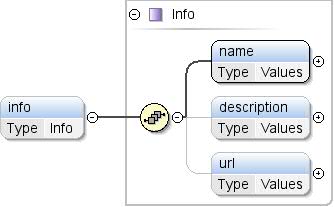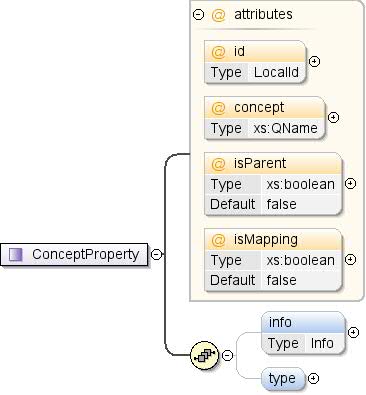コンポーネント: ConceptProperty
コレクションでコンテンツを整理
必要に応じて、コンテンツの保存と分類を行います。
| 名前空間 |
http://schemas.google.com/dspl/2010 |
| アノテーション |
コンセプト プロパティに関するテキスト情報。 |
| 図 |
 |
| タイプ |
情報 |
| プロパティ |
|
| モデル |
name、description{0,1}、url{0,1} |
| 子供 |
description、name、url |
| インスタンス |
<info>
<name>{1,1}</name>
<description>{0,1}</description>
<url>{0,1}</url>
</info>
|
| ソース |
<xs:element name="info" type="Info" minOccurs="0">
<xs:annotation>
<xs:documentation>Textual information about the concept property.</xs:documentation>
</xs:annotation>
</xs:element>
|
| 名前空間 |
http://schemas.google.com/dspl/2010 |
| アノテーション |
コンセプト プロパティのデータ型。 |
| 図 |
 |
| プロパティ |
|
| 属性 |
|
| ソース |
<xs:element name="type" minOccurs="0">
<xs:annotation>
<xs:documentation>The data type of the concept property.</xs:documentation>
</xs:annotation>
<xs:complexType>
<xs:attribute name="ref" type="DataType" use="required"/>
</xs:complexType>
</xs:element>
|
複合型: ConceptProperty
| 名前空間 |
http://schemas.google.com/dspl/2010 |
| アノテーション |
コンセプトのプロパティ(たとえば、
あります。 |
| 図 |
 |
| 使用者 |
|
| モデル |
info{0,1}、type{0,1} |
| 子供 |
info、type |
| 属性 |
| QName |
タイプ |
固定 |
デフォルト |
使用 |
Annotation |
| コンセプト |
xs:QName |
|
|
省略可 |
値に対応するコンセプトへの参照
指定します。プロパティで型が指定されている場合、その型は
参照されるコンセプトのタイプと一致している必要があります。参照:
外部コンセプトは、
"prefix:other_concept_id"("prefix")
外部データセットの名前空間に使用される接頭辞(XML を参照
実装します。 |
| id |
LocalId |
|
|
省略可 |
コンセプト プロパティの ID。この識別子は、
(属性とプロパティ全体で)一意でなければなりません。「
コンセプト プロパティが指定されている場合、id は省略できます。その
ID は、サービス アカウントのローカル名の値で暗黙的に作成されます。
参照されるコンセプトです。例: <property
concept="geo:country"/><property> と同等です。
id="country"
concept="geo:country"/> |
| isMapping |
xs:boolean |
|
false |
省略可 |
true の場合、このプロパティはコンセプトを参照する必要があり、
このプロパティは、この 2 つのテーブル間のマッピング(1 対 1)
参照されるコンセプトです参照される各インスタンスは、
各コンセプトは、最大 1 つのインスタンスで
コンセプトです。 |
| isParent |
xs:boolean |
|
false |
省略可 |
true の場合、このプロパティはコンセプトを参照する必要があり、
このプロパティは、この 2 つのエンティティ間の
参照されるコンセプト(例: 大陸の大陸)を
国)。 |
|
| ソース |
<xs:complexType name="ConceptProperty">
<xs:annotation>
<xs:documentation>A property of a concept (e.g., the country of a city).</xs:documentation>
</xs:annotation>
<xs:sequence>
<xs:element name="info" type="Info" minOccurs="0">
<xs:annotation>
<xs:documentation>Textual information about the concept property.</xs:documentation>
</xs:annotation>
</xs:element>
<xs:element name="type" minOccurs="0">
<xs:annotation>
<xs:documentation>The data type of the concept property.</xs:documentation>
</xs:annotation>
<xs:complexType>
<xs:attribute name="ref" type="DataType" use="required"/>
</xs:complexType>
</xs:element>
</xs:sequence>
<xs:attribute name="id" type="LocalId" use="optional">
<xs:annotation>
<xs:documentation>The id of the concept property. This identifier must be unique within the concept
(across attributes and properties).
The id may be omitted if the concept property is specified. In that case, an id is
implicitly created with value the local name of the referenced concept. For instance
<property concept="geo:country"/>
is equivalent to
<property id="country" concept="geo:country"/></xs:documentation>
</xs:annotation>
</xs:attribute>
<xs:attribute name="concept" type="xs:QName" use="optional">
<xs:annotation>
<xs:documentation>A reference to a concept that corresponds to the values of the property.
If the property specifies a type, then the type must match the type of the
referenced concept.
A reference to an external concept must be of the form "prefix:other_concept_id",
where "prefix" is the prefix used for the namespace of the external dataset
(see XML namespaces).</xs:documentation>
</xs:annotation>
</xs:attribute>
<xs:attribute name="isParent" type="xs:boolean" use="optional" default="false">
<xs:annotation>
<xs:documentation>If true, then this property must reference a
concept, and this property denotes a hierarchical
relationship between this concept and the referenced
concept (e.g., the continent of a country).</xs:documentation>
</xs:annotation>
</xs:attribute>
<xs:attribute name="isMapping" type="xs:boolean" use="optional" default="false">
<xs:annotation>
<xs:documentation>If true, then this property must reference a
concept, and this property denotes a mapping
(1-to-1) relationship between this concept and the
referenced concept. Each instance of the referenced
concept is referenced by at most one instance of
this concept.</xs:documentation>
</xs:annotation>
</xs:attribute>
</xs:complexType>
|
| 名前空間 |
名前空間がありません |
| タイプ |
DataType |
| プロパティ |
|
| ファセット |
| enumeration |
文字列 |
|
| enumeration |
float |
|
| enumeration |
integer |
|
| enumeration |
ブール値 |
|
| enumeration |
date |
|
| enumeration |
concept |
|
|
| 使用者 |
|
| ソース |
<xs:attribute name="ref" type="DataType" use="required"/>
|
| 名前空間 |
名前空間がありません |
| アノテーション |
コンセプト プロパティの ID。この ID は一意である必要があります
(属性とプロパティにまたがる)。ID は
コンセプト プロパティが指定されている場合は省略されます。この場合、ID は
参照先のコンセプトのローカル名の値で暗黙的に作成されます。
例: <property concept="geo:country"/>
<property id="country" と同等
concept="geo:country"/> |
| タイプ |
LocalId |
| プロパティ |
|
| ファセット |
|
| 使用者 |
|
| ソース |
<xs:attribute name="id" type="LocalId" use="optional">
<xs:annotation>
<xs:documentation>The id of the concept property. This identifier must be unique within the concept
(across attributes and properties).
The id may be omitted if the concept property is specified. In that case, an id is
implicitly created with value the local name of the referenced concept. For instance
<property concept="geo:country"/>
is equivalent to
<property id="country" concept="geo:country"/></xs:documentation>
</xs:annotation>
</xs:attribute>
|
| 名前空間 |
名前空間がありません |
| アノテーション |
プロパティです。プロパティで型を指定する場合、その型は
参照されるコンセプトの型です。外部コンセプトを参照する場合は、
「prefix:other_concept_id」の形式にする必要があります。
"接頭辞"外部 IP アドレスの名前空間に使用される接頭辞です。
(XML 名前空間を参照)。 |
| タイプ |
xs:QName |
| プロパティ |
|
| 使用者 |
|
| ソース |
<xs:attribute name="concept" type="xs:QName" use="optional">
<xs:annotation>
<xs:documentation>A reference to a concept that corresponds to the values of the property.
If the property specifies a type, then the type must match the type of the
referenced concept.
A reference to an external concept must be of the form "prefix:other_concept_id",
where "prefix" is the prefix used for the namespace of the external dataset
(see XML namespaces).</xs:documentation>
</xs:annotation>
</xs:attribute>
|
| 名前空間 |
名前空間がありません |
| アノテーション |
true の場合、このプロパティはコンセプトを参照する必要があり、
プロパティは、このコンセプトと
概念(国の大陸など)で表現されます。 |
| タイプ |
xs:boolean |
| プロパティ |
| 次のコマンドを使用します。 |
省略可 |
| default:
|
false |
|
| 使用者 |
|
| ソース |
<xs:attribute name="isParent" type="xs:boolean" use="optional" default="false">
<xs:annotation>
<xs:documentation>If true, then this property must reference a
concept, and this property denotes a hierarchical
relationship between this concept and the referenced
concept (e.g., the continent of a country).</xs:documentation>
</xs:annotation>
</xs:attribute>
|
| 名前空間 |
名前空間がありません |
| アノテーション |
true の場合、このプロパティはコンセプトを参照する必要があり、
プロパティは、この概念と 1 対 1 のマッピング関係を示します。
参照されます。参照されるコンセプトの各インスタンスは、
最大 1 つのインスタンスで参照できます。 |
| タイプ |
xs:boolean |
| プロパティ |
| 次のコマンドを使用します。 |
省略可 |
| default:
|
false |
|
| 使用者 |
|
| ソース |
<xs:attribute name="isMapping" type="xs:boolean" use="optional" default="false">
<xs:annotation>
<xs:documentation>If true, then this property must reference a
concept, and this property denotes a mapping
(1-to-1) relationship between this concept and the
referenced concept. Each instance of the referenced
concept is referenced by at most one instance of
this concept.</xs:documentation>
</xs:annotation>
</xs:attribute>
|
次を使用して作成:
oXygen XML エディタ。
特に記載のない限り、このページのコンテンツはクリエイティブ・コモンズの表示 4.0 ライセンスにより使用許諾されます。コードサンプルは Apache 2.0 ライセンスにより使用許諾されます。詳しくは、Google Developers サイトのポリシーをご覧ください。Java は Oracle および関連会社の登録商標です。
最終更新日 2025-07-25 UTC。
[[["わかりやすい","easyToUnderstand","thumb-up"],["問題の解決に役立った","solvedMyProblem","thumb-up"],["その他","otherUp","thumb-up"]],[["必要な情報がない","missingTheInformationINeed","thumb-down"],["複雑すぎる / 手順が多すぎる","tooComplicatedTooManySteps","thumb-down"],["最新ではない","outOfDate","thumb-down"],["翻訳に関する問題","translationIssue","thumb-down"],["サンプル / コードに問題がある","samplesCodeIssue","thumb-down"],["その他","otherDown","thumb-down"]],["最終更新日 2025-07-25 UTC。"],[],["ConceptProperty defines a characteristic of a concept, with optional `info` and `type`. The `info` contains text about the property, including `name`, `description`, and `url`. `type` specifies the data type. Attributes include an optional `id` for unique identification, an optional `concept` to reference related concepts, `isParent` (hierarchical relationship), and `isMapping` (1-to-1 relationship), both booleans, defaulting to `false`. The `@ref` attribute is required for type and defines the data type of the referenced concept.\n"]]



